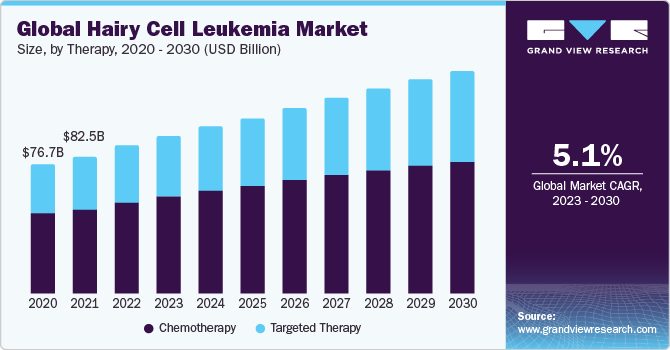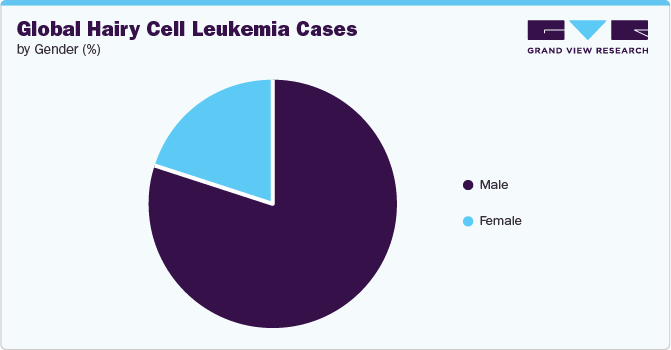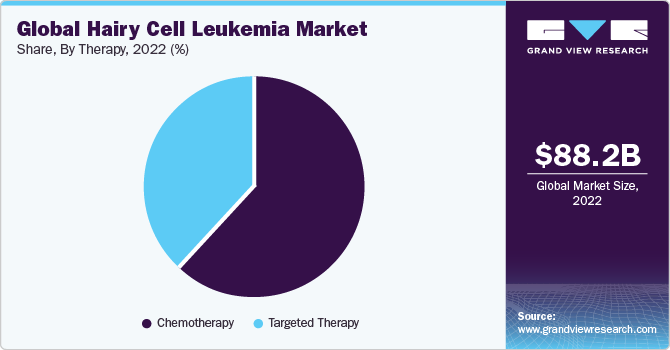- Home
- »
- Pharmaceuticals
- »
-
Hairy Cell Leukemia Market Size, Share, Growth Report 2030GVR Report cover
![Hairy Cell Leukemia Market Size, Share & Trends Report]()
Hairy Cell Leukemia Market Size, Share & Trends Analysis Report, By Therapy (Chemotherapy, Targeted Therapy), By Region, And Segment Forecasts, 2023 - 2030
- Report ID: GVR-4-68040-173-0
- Number of Report Pages: 150
- Format: PDF, Horizon Databook
- Historical Range: 2018 - 2021
- Forecast Period: 2023 - 2030
- Industry: Healthcare
Hairy Cell Leukemia Market Size & Trends
The global hairy cell leukemia market size was valued at USD 88.2 billion in 2022 and is expected to grow at a compound annual growth rate (CAGR) of 5.06% from 2023 to 2030. The increasing incidence of hairy cell leukemia, particularly in older adults, is a fundamental driver that drives the market. For instance, as per data published by the Mayo Clinic in 2022, hairy cell leukemia predominantly strikes individuals in their fifth or sixth decade of life. Furthermore, the same source indicates a higher incidence of this condition among men compared to women.

Advancements in research significantly drive the HCL market by providing a deeper understanding of the disease's underlying molecular and genetic mechanisms. This improved understanding has led to the development of targeted therapies and innovative treatment approaches that are more effective and have fewer side effects than traditional chemotherapy. For instance, according to the Economic Co-operation and Development (OECD) report published in 2022, the U.S. allocated 3.4% of its GDP to research and development activities in 2021, while Canada devoted 1.60% of its GDP to the same purpose during the same year. As research continues to uncover new therapeutic targets and treatment strategies, it not only enhances patient outcomes but also stimulates pharmaceutical companies to invest in HCL-specific drug development, ultimately expanding the range of treatment options available in the market and improving the overall quality of care for HCL patients.
Further, the development of drugs that specifically target the abnormal proteins responsible for HCL has improved patient outcomes and reduced side effects. Unlike conventional chemotherapy, which can be harsh and result in significant side effects, targeted therapies such as BRAF inhibitors have revolutionized HCL treatment by significantly improving patient outcomes while minimizing adverse effects. Patients and healthcare providers increasingly prefer these treatments, and pharmaceutical companies continue to invest in research and development of new targeted therapies, cementing their dominance in the HCL market as safer and more effective alternatives to traditional chemotherapy.

Moreover, awareness and screening programs play a pivotal role in propelling the HCL market by increasing early detection and diagnosis rates. These programs create a heightened understanding of HCL, its risk factors, and the importance of regular health check-ups among both the public and healthcare professionals. As a result, more cases of HCL are diagnosed at an earlier, more treatable stage. Early intervention is critical in improving patient outcomes, as it allows for timely access to effective therapies, reducing the disease burden and mortality rates. Additionally, these programs foster a supportive environment for patients, encourage research, and contribute to the growth of the HCL market by expanding the patient pool in need of treatment and care.
Therapy Insights
On the basis of therapy, the market is segmented intochemotherapy, and targeted therapy. The chemotherapy segment held the largest market share in 2022due to its efficacy in treating this rare blood cancer. It remains the primary choice for most HCL cases because it can effectively target and eradicate abnormal leukemic cells.

Additionally, it's a more cost-effective treatment option, making it accessible to a broader range of patients. On the other hand, targeted therapy is expected to witness lucrative growth over the forecast period due to its precise and effective approach in treating the disease.
Regional Insights
North America dominated the market in 2022 due to several factors, including advanced healthcare infrastructure, a high prevalence of the disease in the region, and substantial investments in medical research and drug development. The region has well-established healthcare systems and regulatory frameworks that facilitate the rapid adoption of new treatments. Moreover, the region's robust pharmaceutical and biotechnology industries have been at the forefront of developing innovative therapies, including targeted drugs, which have significantly improved patient outcomes.
On the other hand, Asia Pacific is expected to witness lucrative growth over the forecast period. The rising healthcare infrastructure, increasing access to healthcare services, and growing population in the region are the major factors that drive the overall market growth in the region.
Key Companies & Market Share Insights
Key players operating in the market are Amgen Inc., AstraZeneca PLC, Gilead Sciences, Hoffmann-La Roche Ltd, Astellas Pharma, Johnson & Johnson, Merck KGaA, and Pfizer Inc. The market participants are constantly working towards new product development, M&A activities, and other strategic alliances to gain new market avenues. In August 2022, AstraZeneca obtained FDA approval for a tablet form of the medication known as Calquence, designed for the treatment of chronic lymphocytic leukemia (CLL), small lymphocytic leukemia (SLL), and mantle cell lymphoma (MCL) that has relapsed or not responded to prior treatment.
Share this report with your colleague or friend.
![gvr icn]()
NEED A CUSTOM REPORT?
We can customize every report - free of charge - including purchasing stand-alone sections or country-level reports, as well as offer affordable discounts for start-ups & universities. Contact us now
![Certified Icon]()
We are GDPR and CCPA compliant! Your transaction & personal information is safe and secure. For more details, please read our privacy policy.
We are committed towards customer satisfaction, and quality service.
"The quality of research they have done for us has been excellent."





